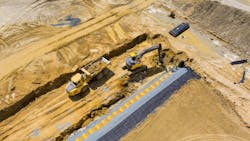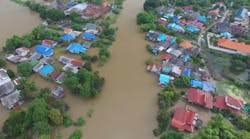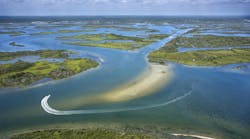Combating water scarcity with stormwater harvesting
In just one week last September, over 150 million people across the U.S. were affected by drought. These dry conditions increase dependence on groundwater, which is an already overused resource. A recent study published in Nature found that excessive extraction of groundwater is causing 28 major cities to sink. Compounding the issue, drought-hardened soil struggles to absorb water during heavy rainfall, leading to runoff and flash flooding, rather than recharging groundwater. As the U.S. continues to face warming temperatures, droughts will become more intense, and the warmer air will lead to heavier rainfall during storms.
All that rainfall will generate significantly more stormwater. A 2024 report from the Pacific Institute estimates U.S. urban areas may see 59.5 million acre-feet of stormwater runoff annually on average — equivalent to more than 53 billion gallons per day, enough to fill over 80,000 Olympic-sized swimming pools daily, and 93% of municipal and industrial water withdrawals
There is an immense opportunity to use stormwater harvesting for water reuse and combat water scarcity in situations where the demand for water is greater than the available supply.
The growing crisis of water scarcity
The U.S. Geological Survey’s 2025 National Water Availability Assessment found that nearly 30 million Americans reside in areas where surface-water supplies are limited, indicating a high level of water limitation. Today, cities in the Southwest and South, like Las Vegas, Houston and Atlanta, face water scarcity due to population growth outpacing water infrastructure capacity and aquifers being depleted at alarming rates.
Many cities in the West rely on water sources that are diminishing quickly. Legal battles over water rights with neighboring states are already taking place and have even reached the U.S. Supreme Court, like the case of Texas v. New Mexico and Colorado.
If left unresolved, water scarcity in the U.S. could impact nearly every aspect of life, triggering human, economic, and environmental consequences. Proactive investments in solutions like stormwater harvesting, water reuse, and water conservation are crucial to avoid this scenario.
Why we should tap into stormwater harvesting’s potential
In the 2025 Report Card for America’s Infrastructure, the American Society of Civil Engineers (ASCE) assigned the U.S. stormwater infrastructure a troubling grade of “D.” This low rating reflects the widespread inability of current systems to handle intense rainfall events, especially in western cities that often experience heavy downpours over short periods, such as during the monsoon season. When stormwater infrastructure is overwhelmed, it leads to flooding, property damage, and lost opportunities to capture valuable water resources.
But there is good news. There are now many cost-effective solutions, such as cisterns and modular systems that can scale and adapt to meet space restrictions while still effectively capturing, conveying, storing, and treating the necessary amount of water needed.
To effectively utilize stormwater management, engineers need to bring it up early in the design process. Whether building new developments or retrofitting buildings, parks and parking lots, among others, engineers will need to establish how much space they have, how much water they will need, what the water will be reused for and if it’s for internal, external or potable use. Common stormwater applications include irrigation, street cleaning and dust control, fire suppression, sanitary sewer and toilet flushing, among others.
Today’s modular systems can be specially designed to hold more than a million gallons under a huge warehouse, or to fit in the smallest of footprints. Customizable storage systems can release water through a controlled outlet or retain it until the surrounding soil can accept infiltration. Hypertension systems can also be used with pipe systems to retain water. All of these can be utilized for industrial, commercial and even single-family residence use.
Managing stormwater can also help engineers and developers meet regulatory guidelines for the project at hand by utilizing the following methods:
- Volume Reduction: Minimize the amount of runoff that leaves a site during and after rainfall. Retain stormwater on-site with the aim to absorb, infiltrate or reuse the water on-site, thereby reducing the capacity and size of on-site detention.
- Rate Control: Slow water discharge to the drainage system so it does not overwhelm infrastructure to mitigate flooding and erosion.
- Water Quality: Pre-treatment to address contaminates (e.g. filtration for gross solids, phosphorus, metals and oil/grease).
- Land Use Optimization: Help to reduce the amount of land required for traditional detention systems through underground detention systems, allowing for the potential sale of additional lots and property.
Regardless of the size and scope of the project, if stormwater management is addressed early in the conversation, it can not only help municipalities and developers with everyday water needs but also ensure the long-term water supply.
Francisco street reservoir
Underneath the 4.5-acre Francisco Park is a stormwater capture and reuse system that took the place of a decommissioned drinking water reservoir and now stores more than 500,000 gallons to flush toilets and almost entirely irrigate the park. The collected stormwater is treated to meet San Francisco Department of Public Health non-potable water standards.
The stormwater is first stored in a cistern at the top of the hill before being transferred to the service building where it flows through a series of filtration and disinfecting processes — this ensures that the water meets public health regulations. Half the runoff is collected via gravity flow, due to the site’s nearly 20 percent slope, and the rest collected at the bottom of the site and pumped. All captured runoff flows through the screening filtration and into chambers for storage and later use. This single stormwater harvesting system saves the city 5.7 million liters of potable water every year, freeing up that supply for where it is really needed.
Prioritizing water harvesting is critical
By prioritizing water harvesting and reuse in planning, funding and design, the U.S. can address water scarcity challenges while making better use of existing resources.
About the Author
Michelle Manning
Michelle Manning is product director for the Store Portfolio at ADS, where she leads the commercialization of underground stormwater detention and retention systems, including StormTech and Aquabox, as well as ADS’s water harvesting initiative. She focuses on delivering practical, scalable solutions that bring long-term value to customers managing evolving water challenges.



